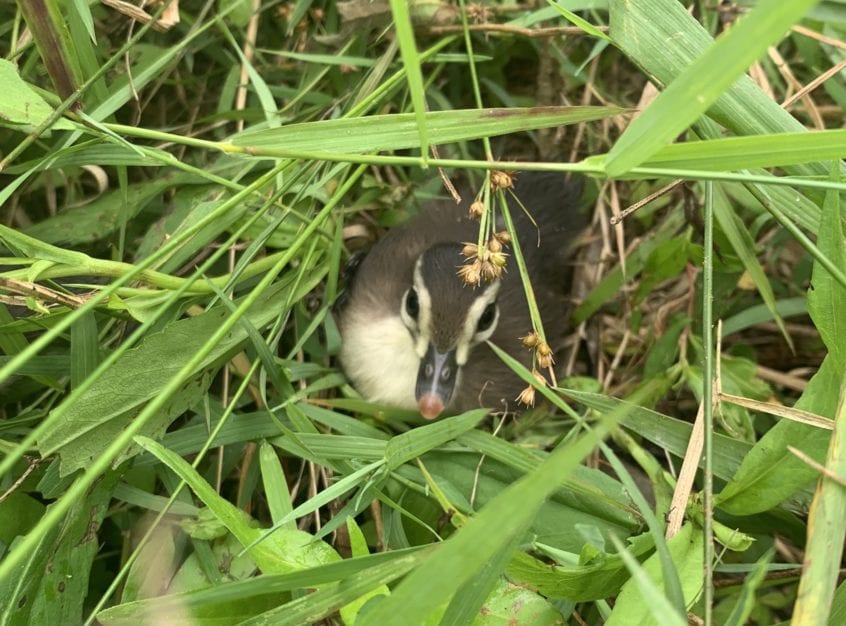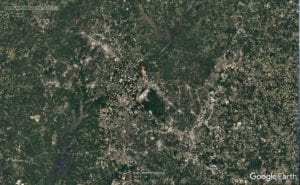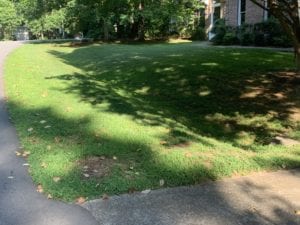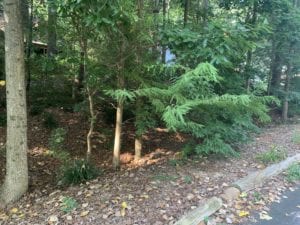
Habitat Loss
What is your habitat? And, how do you share that habitat with the animals and plants around you? What is the same and what is different? Habitat is defined as a place where organisms live and grow. Open your favorite mapping application such as Google Earth and zoom into your location or nearest municipality. Now, slowly zoom out to each scale; municipality, county, physiographic region, State, and/or ecoregion. Notice where intact habitats occur, usually along large river corridors, contributing streams, large coastal wetlands, State and National parks, and National Forests. Light areas correspond with human habitat expansion, and dark green areas are more intact, relatively undisturbed, or protected habitats for our wildlife neighbors.

Google Earth satellite image of habitat fragmentation (note dark green area in the middle = State Park)
While this is a broad, general view of habitat fragmentation, it is an obvious one that can easily be shared visually with others to show how we all are losing habitat in rapidly growing regions of the country.
Humans share the habitats of the planet with a tremendous diversity of organisms from the lowest elevation coastal areas, to the highest mountain environs. While human habitat expands through housing development, natural resource extraction, infrastructure construction, land-use changes, fire suppression, and food production, other plants, animals, and organisms are often displaced to more suitable remaining habitats. This happens on many scales and each project impacting habitat can cause habitat fragmentation and add up to large-scale effects.
Too much habitat destruction and displacement of organisms can lead to species decline and sometimes threaten a species existence. Federal and State regulations are in place to ultimately protect individual species that are threatened or endangered. Federal regulations such as the National Environmental Policy Act (NEPA) provide public input and environmental review to safeguard important habitats vital to ecosystem services. However, current changes effective July 15, 2020, to these laws undermine environmental protections held in place for decades. And, habitats along with threatened and endangered wildlife will be impacted. Other State and Federal regulations that protect water quality or open space indirectly improve or increase species habitat through riparian corridors, expanded forested buffers, habitat connectivity, and change of land use. These regulations help support overall ecosystem restoration on both local and regional scales.
Specifically, in North Carolina and other states, wetland and stream mitigation projects aid in mitigating not only natural resource impacts but also help mitigate habitat fragmentation resulting from impacts within a service area or specific watershed. Habitats, including buffers around restored wetlands and streams, are becoming recognized more and more for not only their value buffering the resource restored but also for improving habitat connectivity and ecosystem services outside of existing credit and regulatory-driven markets.
Many conservation groups, scientists, and municipal planners also recognize the value of habitat protection, restoration, and “open space” preservation for both humans and wildlife. Large scale efforts are underway to restore habitats like the Everglades, large river corridors, migratory bird flyways, and green corridors through major urban areas.

Managed lawn and minimal habitat
Why protect habitats and promote connectivity and wildlife corridors? The interconnectedness of habitat with our daily lives is undeniable. We need ecosystems and their inhabitants to thrive in order to promote ecosystem services such as clean air, clean water, and food security. While activities such as riparian corridor restoration promote habitat restoration and preservation, there are many things we can do on a personal level to help connect fragmented areas on a small scale with big results. Many homeowners may discover a simple way to help offset habitat loss is by planting native trees and plants that help improve habitats for flying creatures such as insects, bats, and birds. Trees and shrubs provide nesting, foraging, and resting habitats for these organisms and help connect disjunct forests, field edges, and stream corridors.

Restored native forest edge habitat
Planting native flower gardens that attract pollinating insects also bridge large gaps in habitat loss for these insect species and helps to pollinate local gardens, support food co-op plants, and honey-bee populations. Often native plants are overlooked for their beauty, disease resistance, longevity, and resilience to local weather patterns compared to some non-native plant species and more common, often cheaper ornamental varieties. Converting open grassed areas to native trees or gardens also promotes habitat establishment and restoration in fragmented urban or semi-urban landscapes.
We can all be a part of this effort, replanting and converting sterile landscapes of manicured lawns and non-native ornamental trees and shrubs found in suburbs, highway medians, parking lot islands, and city parks. Doing so will help stitch up our fragmented habitat landscape and connect private and public lands together, promoting ecosystem services as well as keystone species that support food security for humans.
Participating in habitat restoration connects humans more with the natural environment shifting our tendency to separate ourselves from the “deep dark woods.” We all can be a part of the solution of protecting and restoring native habitats whether supporting mitigation scale projects or right at home in your own backyard.